Szulernia in the Presidential Palace and rapes in the capital during the civil war. But also great victories, conquests and far-reaching plans that made the sultans and tsars tremble. The Polish-Lithuanian Commonwealth was a fascinating land of contrasts ...
As always, all TOP10 items are based on the articles we publish. This time we decided to show how interesting and multidimensional history of the First Republic of Poland was.
It's hard to believe that:
10. Hetman Jan Sobieski wanted to overthrow the king
In 1672, some of the nobility wanted to place Prince Charles de Longueville on the Polish throne. During a private audience, Primate Mikołaj Prażmowski asked the king to abdicate himself.
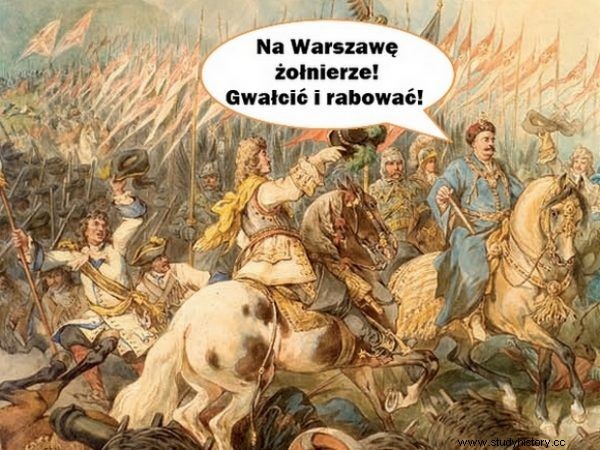
Nobody portrayed the embarrassing episode when the troops under Sobieski's command set off on their own capital. We can only imagine it looked something like this…. (Illustrated:The Battle of Vienna by Juliusz Kossak).
Michał Korybut Wiśniowiecki did not agree, so Jan Sobieski introduced 14 army banners into the capital, which did not avoid rapes and robberies. . The soldiers also attacked the helpless royal guard. Malcontents announced a manifesto in which they declared that they had come to Warsaw to remove the king. Among the accusations were allegations of inadequate royal dress, mistreatment of the queen and ... improper games with boys.
The plans of the party of Jan Sobieski were interrupted by the unexpected death of Karol. Primate Prażmowski was said to have said that: he would prefer half of my homeland to perish than one bachelor de Longueville . Sobieski did not know that this was the best possible development for him. He soon became a king and a national hero (read more on that) .
9. The hussars fell because of ... goats?
In the era of the hussars, carts moving in a row, manned with armed men, were used to defend against cavalry. When the rolling stock stopped, the carts were chained and dug around the ditch. In the 17th century, Muscovites eagerly used plank walls with loopholes, which also protected people during the march.

The Spanish goats were as effective as the stationary mare (shown), and thanks to their design and low weight, they could be moved around the battlefield. Drawing from the collection of Radosław Sikora.
In Western Europe, something else was invented. The so-called Spanish goats, thanks to its design and low weight, it could be moved around the battlefield . They also did not get shredded, as could be done with a series of short peaks stuck into the ground.
Spanish goats were used by the Swedes in the Battle of Kliszów in 1702 . They stopped the charge of Polish hussars and tankers. It was not the fire of a modernized firearm, as some would believe, but it was the goats that allowed the infantry to successfully face the hussars (read more on this topic) .
8. The victory at Kircholm was well exploited
The Battle of Kircholm is usually referred to as an unused victory. And if this battle was called Riga's relief - as it was - the perspective would change immediately. In 1605, today's Latvian capital was the second city in the Polish-Lithuanian Commonwealth. The victory over the Swedes saved Riga.
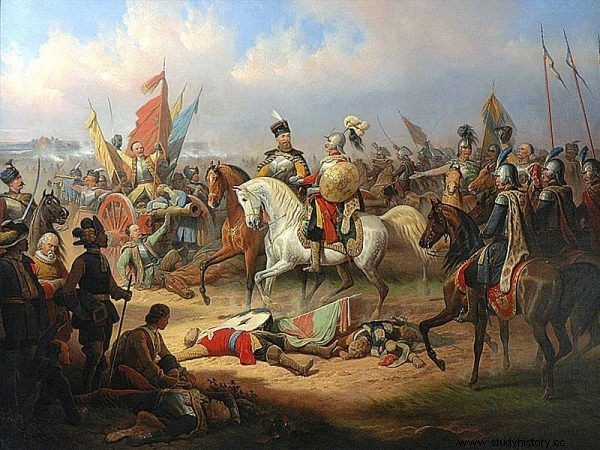
Despite the enormous numerical advantage, the Swedes lost at Kircholm. And the Poles took advantage of their victory. The painting "After the Battle of Kircholm" by Jan Suchodolski (source:public domain).
A few years after Kircholma, Hetman Chodkiewicz conducted secret negotiations with the authorities of Rewel, today's Tallinn, and had already agreed with them the conditions for their transition to the rule of the Polish-Lithuanian Commonwealth! The problem was that this one had a new direction of expansion - Moscow. There is no need to hide, Russia offered more opportunities than northern Estonia.
We lost Riga itself in 1621 when the troops of the Republic of Poland near Khotyn resisted the great Turkish army. The Swedes then stabbed us in the back (read more about it) .
7. Our troops were much smaller than we think
Polish armies seem much larger than they really were. The Hussars' hundred-unit rota is a unit for which one hundred wages were paid from the state treasury, and not one with one hundred cavalry. First, the officers - quite legally - charged extra pay for themselves. As a result, at least every tenth rider existed only on paper.
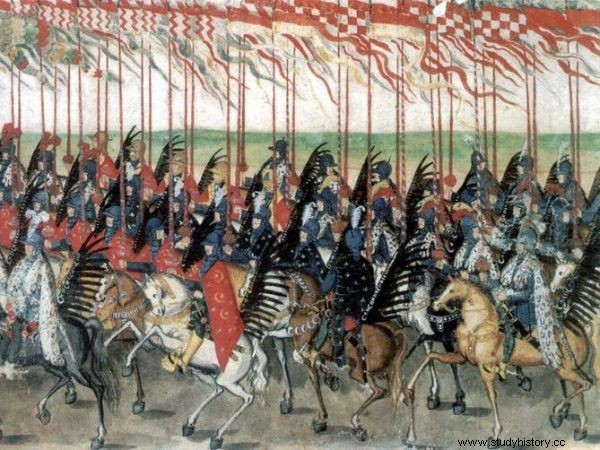
During the parade, the troops looked great ... but after a long campaign, their numbers were significantly reduced. Presentation of the hussars in Krakow in 1605 on the "Polish Rulona" by Balthasar Gebhardt (source:public domain).
Secondly, the pay did not translate into the real number of soldiers, especially when the pay was overdue. The wounded, sick, unfit for duty, killed and deserters were not taken away then. After a long campaign, only 20 riders could remain in the hundred-ton hussar rota.
In the battle of Domanami in 1655, the Polish driveway had between two and two and a half thousand full-time riders, and in real terms:slightly over a thousand. During the street fights in Mogilev in the same year out of five hundred "full-time" cavalrymen only 150 entered the competition. But even the depleted troops of the Polish hussars won the battle time and time again (read more on this topic) .
This article has more than one page. Please select another one below to continue reading.Attention! You are not on the first page of the article. If you want to read from the beginning click here.
6. We almost broke up Turkey in an alliance with the Persians
Jan III Sobieski, after the victory at Vienna in 1683, planned a general deal with the Ottoman Empire. To this end, he decided to make an alliance with Persia.
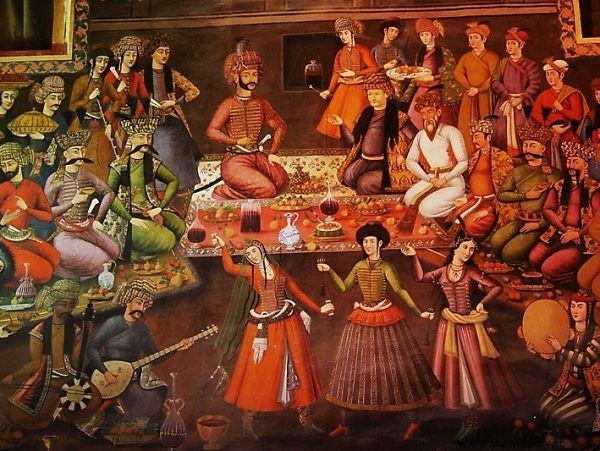
Shah's banquet in honor of foreign dignitaries. Fresco from the Chehel Sotoun Palace in Isfahan, the capital of Persia at that time (photo:Sorosh Tavakoli, license CC BY 2.0).
The Shah rejoiced at the defeat of his greatest enemy and said to the Polish envoy: Tell your Lord that as soon as he conquers Constantinople, I myself, along with my court and all the officials in my country, will soon accept Christianity! Then he ordered the wine to be served and he got drunk in honor of the Polish king.
In 1685, other envoys of Sobieski reached Persia. They tempted the Shah with the vision of taking over Mecca, which was to bring huge revenues from pilgrim fees. The Persians began to amass troops on the Turkish border, but they suspended their preparations after a few weeks. The Turks won the Grand Vizier for their cause. Polish deputies heard then , that religion does not allow the Persians to go against the Turks (read more on this) .
5. We almost captured Ivan IV the Terrible
One day in August 1581, Ivan IV was resting in Staritsa on the Volga. Suddenly, the peace was disturbed by the report of the appearance of Polish-Lithuanian banners in the area. The terrified tsar looked from the walls at the burning villages and chutory. He had only 700 shooters at hand. There was not much he could do with such a handful.
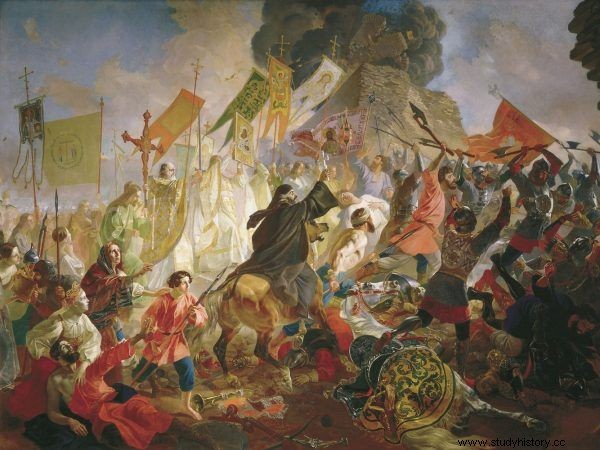
When Batory was sitting near Pskov, Krzysztof Radziwiłł set off into the interior of the Duchy of Moscow. The painting "The Siege of Pskov" by Karl Bryullov (source:public domain).
The perpetrator of the panic was the Lithuanian field hetman, Prince Krzysztof Radziwiłł. While Polish-Lithuanian forces besieged Pskov, he tried to prevent the concentration of enemy troops. His squad of six thousand horses headed east through forests and swamps.
Prince Radziwiłł dissolved his people in three columns, giving them the order to plunder. It was then that one of the beds arrived in the vicinity of Starica. Ivan was saved from captivity by a fugitive, who told the Poles about the alleged power surrounding the prince. Radziwiłł returned to Pskov, in less than three months he traveled as much as fourteen hundred kilometers on poor roads (read more on this topic) .
4. Stockholm was ours
Sparta had three hundred, we were twelve! A storm threw them on the coast near Stockholm on the night of August 30-31, 1598. They were cold and soaked, but their leader, Samuel Łaski, decided to take the city.
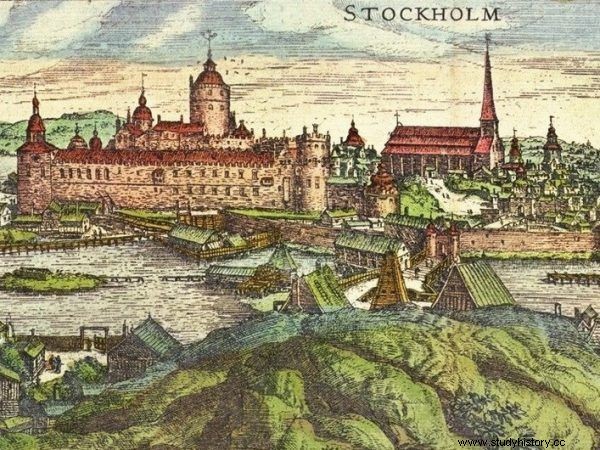
Samuel Łaski only needed 12 people to conquer Stockholm (source:public domain).
Poles entered the capital of Sweden to the accompaniment of thunder and took the town hall . In the morning they called the patricians to announce the takeover of the city by the king of Poland! This is the only time Stockholm has fallen into non-Scandinavian hands.
Although Sigismund III Vasa had been the king of Sweden for six years, the throne was slipping from his hands due to the actions of his ambitious uncle, Charles. Although officially Zygmunt was going to put things in order in Sweden, in practice it was a military expedition of the Republic of Poland. Our fleet took Kalmar, and then a storm disconnected part of the army ... including a ship with Łaski on board (read more about it) .
3. The Presidential Palace was a gambling den
Prince Marcin Lubomirski, bigamist, freemason and traitor, devoted himself to his passions:theater, opera and playing cards. He rented the Radziwiłł Palace in Warsaw (today's Presidential Palace) and made it a gambling cave. There were balls, concerts and carnival parties.
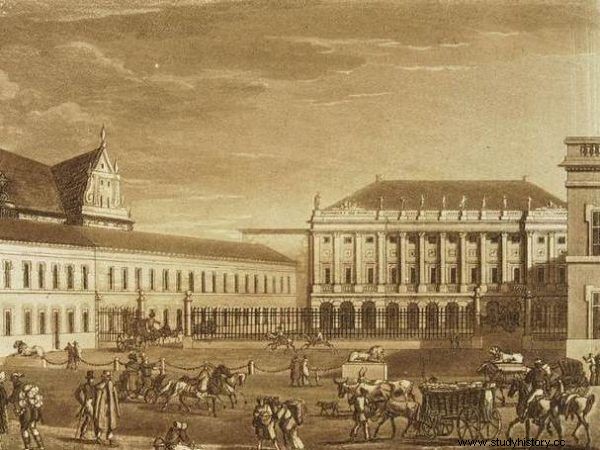
From the present Presidential Palace, Marcin Lubomirski turned into a gambling cave and party center. A postcard from 1820, when the building was called the Governor's Palace (a print by Frederick Dietrich, public domain).
The prince's reputation reached far beyond the borders of Poland - even in Paris he was entered into the register of sharpshooters. Lubomirski's career in this industry ended in 1783, when was legally banned from gambling and the authorities forbade him to sell alcohol .
The prince quickly found a new job. He organized a theater troupe and appointed Wojciech Bogusławski, the father of the Polish national stage, its director. In show business, Lubomirski felt like a fish in water , and in the cultural history of Warsaw he went down in golden letters, providing the residents of the capital with high-quality entertainment. Unfortunately, the prince's profligacy knew no bounds and he eventually went bankrupt (read more about it) .
This article has more than one page. Please select another one below to continue reading.Attention! You are not on the first page of the article. If you want to read from the beginning click here.
2. The traitor Branicki was close to death at the hands of Casanova
In 1765, the famous Casanova came to Warsaw and quarreled immediately with Franciszek Ksawery Branicki. The reason was the dancer, the former Italian's lover, and now Branicki. The magnate challenged Casanova to a duel. During the pistol fight, the Italian asked Branicki to shoot first. The magnate, having lost a few seconds to aim, fired, but not alone. Casanova fired at the same time.
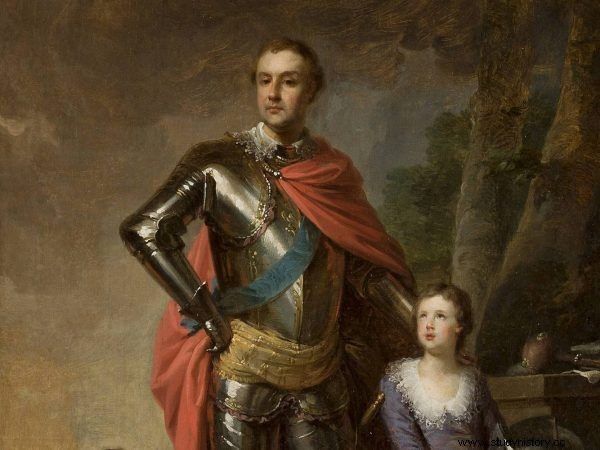
Targowicz, Franciszek Ksawery Branicki, may have died more than 20 years before he became famous as a traitor to the nation. In the painting of Jan the Baptist Lampi with his older son Aleksander (source:public domain).
Branicki fell. The bullet hit him under the seventh rib. Branicki's servants would have killed Casanova if the count had not ordered them to respect the Italian. He had told Casanova: You killed me. Get out, or you're in danger of a gallows.
After a few months, Branicki received him cordially. It turned out that his life was not in danger. Both gentlemen were very nice to each other. The count did not hold a grudge, being grateful for the honorable duel. Casanova expressed how honored this fight was for him (read more about it) .
1. The remedy for potency took away from us an outstanding leader
At the beginning of January 1646, the Grand Hetman of the Crown Stanisław Koniecpolski took part in an important conference in Warsaw. He proposed, in alliance with Russia, to liquidate the Crimean Khanate, place the Polish prince on the Moscow throne, and, after defeating the Tatars, take control of Moldavia, Wallachia, and perhaps Transylvania ...
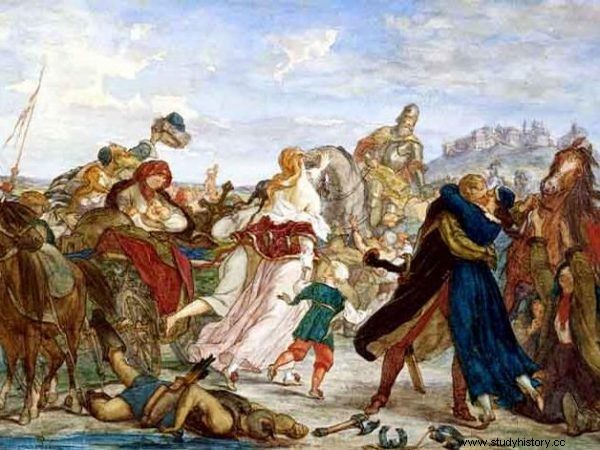
The Grand Hetman of the Crown, Stanisław Koniecpolski, recaptures from Halicz from the hands of the Tatars, taken in the garlands of the citizens of the Republic of Poland. Painting by Henryk Rodakowski (source:public domain).
A week after the Warsaw meeting, 52-year-old Koniecpolski married 25-year-old Zofia Opalińska. The queen's happiness did not last long. Hetman did not exercise moderation in the use of comfort (the then equivalent of the "blue tablet") and took the dose intended for several times. He died a few weeks after the wedding.
Poland lost its great leader at its worst. After Koniecpolski's death, a commander of his format was missing. The plans to liquidate the Crimean Khanate have failed. Two years after the death of the hetman, the Cossacks raised a revolt (read more on this topic) .
